
Arsenopyrite is an iron arsenic sulfide (FeAsS). It is a hard metallic, opaque, steel grey to silver white mineral with a relatively high specific gravity of 6.1. When dissolved in nitric acid, it releases elemental sulfur. When arsenopyrite is heated, it produces sulfur and arsenic vapor. With 46% arsenic content, arsenopyrite, along with orpiment, is a principal ore of arsenic. When deposits of arsenopyrite become exposed to the atmosphere, the mineral slowly converts into iron arsenates. Arsenopyrite is generally an acid-consuming sulfide mineral, unlike iron pyrite which can lead to acid mine drainage.

A pnictogen is any of the chemical elements in group 15 of the periodic table. Group 15 is also known as the nitrogen group or nitrogen family. Group 15 consists of the elements nitrogen (N), phosphorus (P), arsenic (As), antimony (Sb), bismuth (Bi), and moscovium (Mc).

Stibnite, sometimes called antimonite, is a sulfide mineral with the formula Sb2S3. This soft grey material crystallizes in an orthorhombic space group. It is the most important source for the metalloid antimony. The name is derived from the Greek στίβι stibi through the Latin stibium as the former name for the mineral and the element antimony.

Realgar, also known as "ruby sulphur" or "ruby of arsenic", is an arsenic sulfide mineral with the chemical formula α-As4S4. It is a soft, sectile mineral occurring in monoclinic crystals, or in granular, compact, or powdery form, often in association with the related mineral, orpiment. It is orange-red in color, melts at 320 °C, and burns with a bluish flame releasing fumes of arsenic and sulfur. Realgar is soft with a Mohs hardness of 1.5 to 2 and has a specific gravity of 3.5. Its streak is orange colored. It is trimorphous with pararealgar and bonazziite.

Orpiment is a deep-colored, orange-yellow arsenic sulfide mineral with formula As
2S
3. It is found in volcanic fumaroles, low-temperature hydrothermal veins, and hot springs and is formed both by sublimation.

Arsenic trisulfide is the inorganic compound with the formula As2S3. It is a dark yellow solid that is insoluble in water. It also occurs as the mineral orpiment, which has been used as a pigment called King's yellow. It is produced in the analysis of arsenic compounds. It is a group V/VI, intrinsic p-type semiconductor and exhibits photo-induced phase-change properties.

Claudetite is an arsenic oxide mineral with chemical formula As2O3. Claudetite is formed as an oxidation product of arsenic sulfides and is colorless or white. It can be associated with arsenolite (the cubic form of As2O3) as well as realgar (As4S4), orpiment (As2S3) and native sulfur.
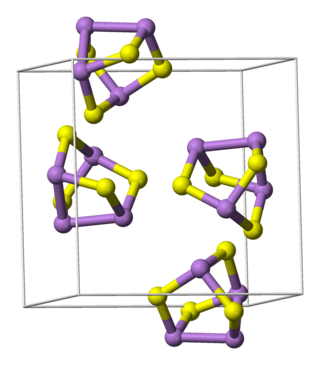
Pararealgar is an arsenic sulfide mineral with the chemical formula As4S4, also represented as AsS. It forms gradually from realgar under exposure to light. Its name derives from the fact that its elemental composition is identical to realgar, As4S4. It is soft with a Mohs hardness of 1 - 1.5, is yellow orange in colour, and its monoclinic prismatic crystals are very brittle, easily crumbling to powder.
Arsenic sulfide may refer to:
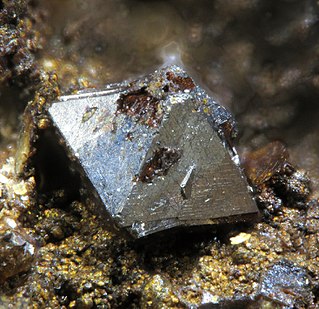
Polydymite, Ni2+Ni23+S4, is a supergene thiospinel sulfide mineral associated with the weathering of primary pentlandite nickel sulfide.
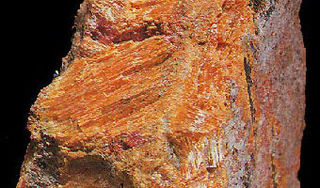
Agathodaemon was an alchemist in late Roman Egypt, known only from fragments quoted in medieval alchemical treatises, chiefly the Anepigraphos, which refer to works of his believed to be from the 3rd century. He is primarily remembered for his various descriptions of elements and minerals, most particularly his descriptions of a method of producing silver, and of a substance he had created, which he called a 'fiery poison', and which, judging by his account, was arsenic trioxide, a highly toxic amphoteric oxide.

Conichalcite, CaCu(AsO4)(OH), is a relatively common arsenate mineral related to duftite (PbCu(AsO4)(OH)). It is green, often botryoidal, and occurs in the oxidation zone of some metal deposits. It occurs with limonite, malachite, beudantite, adamite, cuproadamite, olivenite and smithsonite.
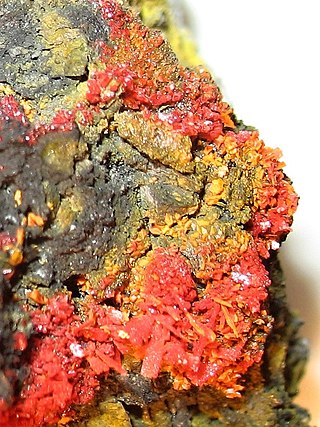
Alacránite (As8S9) is an arsenic sulfide mineral first discovered in the Uzon caldera, Kamchatka, Russia. It was named for its occurrence in the Alacrán silver/arsenic/antimony mine. Pampa Larga, Chile. It is generally more rare than realgar and orpiment. Its origin is hydrothermal. It occurs as subhedral to euhedral tabular orange to pale gray crystals that are transparent to translucent. It has a yellow-orange streak with a hardness of 1.5. It crystallizes in the monoclinic crystal system. It occurs with realgar and uzonite as flattened and prismatic grains up to 0.5 mm across.

Getchellite is a rare sulfide of arsenic and antimony, AsSbS3, that was discovered by B. G. Weissberg of the New Zealand Department of Scientific and Industrial Research in 1963, and approved as a new species by the International Mineralogical Association in 1965. Many metal sulfides are grey to black, but a few are brightly colored. Orpiment is yellow to brownish gold, cinnabar is deep red and getchellite is a bright orange red.

Wakabayashilite is a rare arsenic, antimony sulfide mineral with formula [(As,Sb)6S9][As4S5].
Guettardite is a rare arsenic-antimony lead sulfosalt mineral with the chemical formula Pb(Sb,As)2S4. It forms gray black metallic prismatic to acicular crystals with monoclinic symmetry. It is a dimorph of the triclinic twinnite.
Lucabindiite is a mineral discovered in 1998 from the La Fossa crater at Vulcano, the Aeolian islands off the coast of Italy. It has the chemical formula As4O6(Cl,Br) and is hexagonal. After months of collecting sublimates and encrustations, the researchers discovered lucabindiite which was found on the surface of pyroclastic breccia. The mineral is named after Luca Bindi, who was a professor of mineralogy and former head of the Division of Mineralogy of the Natural History Museum of the University of Florence.
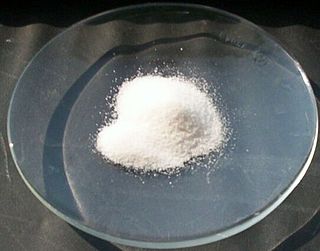
Compounds of arsenic resemble in some respects those of phosphorus which occupies the same group (column) of the periodic table. The most common oxidation states for arsenic are: −3 in the arsenides, which are alloy-like intermetallic compounds, +3 in the arsenites, and +5 in the arsenates and most organoarsenic compounds. Arsenic also bonds readily to itself as seen in the square As3−
4 ions in the mineral skutterudite. In the +3 oxidation state, arsenic is typically pyramidal owing to the influence of the lone pair of electrons.















